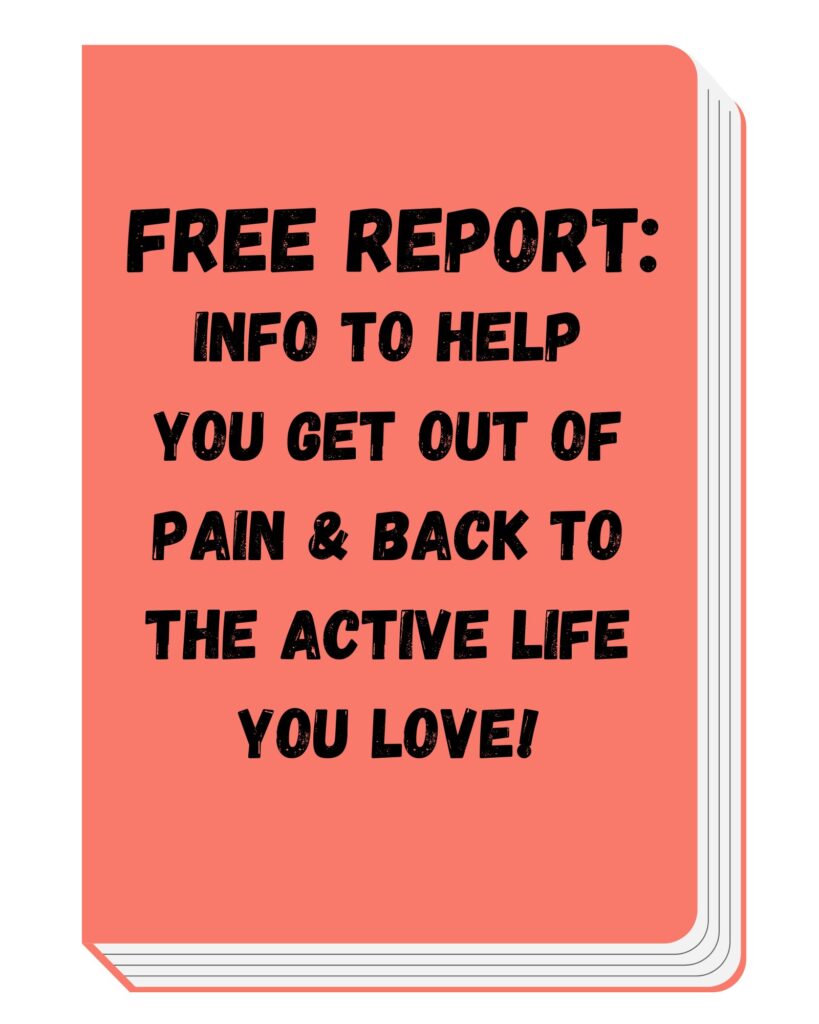
Cycling is one of the gentlest forms of exercise on the joints of the legs & back while providing some of the best cardiovascular training simultaneously. There are various versions of cycling including mountain biking, road biking, leisure biking, ebiking, competitive biking, & recreational biking. All these forms come with risk of injury or exacerbating a current injury. People that bike for recreation are more likely to suffer pain due to starting a new activity they don’t do all the time, biking with a bike that is not fitted properly for them, or from falling & hurting themselves. On the other hand, it’s been studied that the majority of competitive cyclers or those that cycle often usually suffer 1 overuse injury/year & can suffer acute injury (injury happening suddenly due to an accident) from falling or crashing. We’ll discuss some common pain points cyclers suffer here & how best to manage this pain.
Knee Pain
More competitive & recreational cyclers suffer knee pain from overuse, falling, or aggravation of an old injury. The most common conditions that cause knee pain in cyclists include Iliotibial Band Syndrome (ITBS), Patellofemoral Pain Syndrome (PFPS), & pes anserine bursitis. ITBS can cause achy, dull, & sometimes sharp or shooting pain (in severe cases) from the outside of the knee & knee cap up the side of the thigh to the side of the hip at times. This is caused by the iliotibial band or iliotibial tract (Fig. 1 & 2) being tight from scar tissue, muscle weakness, or increased stress & stretch to the side of the knee. Sometimes cyclers will have pain with this with cycling or activities like walking, but sometimes they don’t get pain unless they’ve been resting for a while.
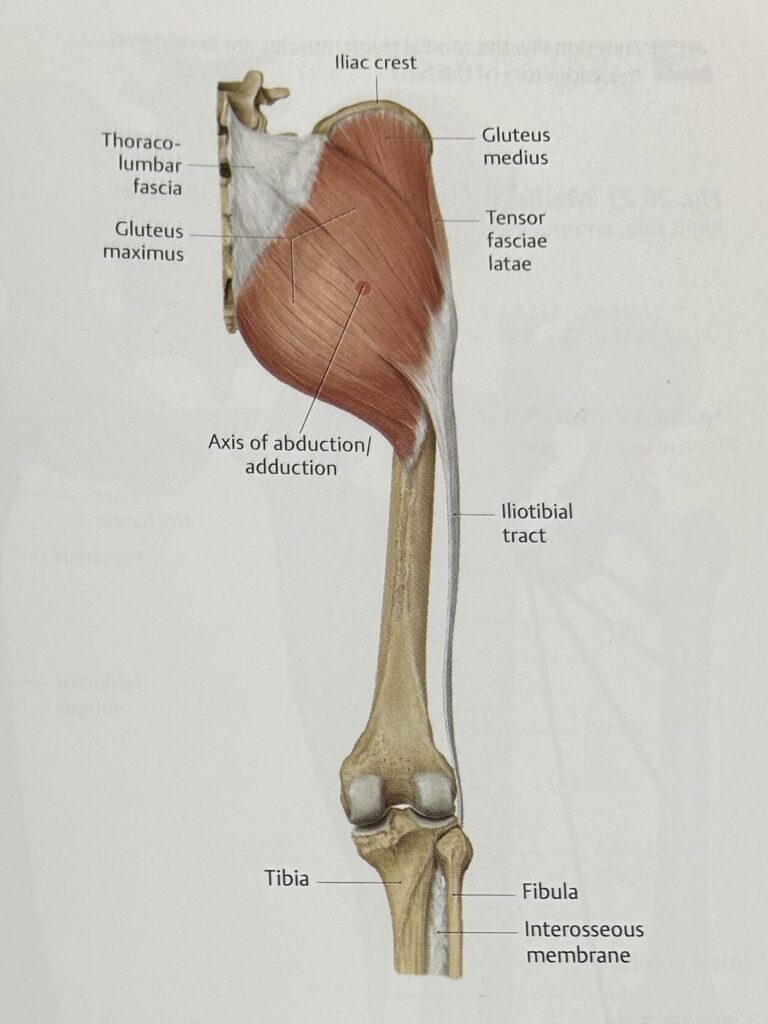
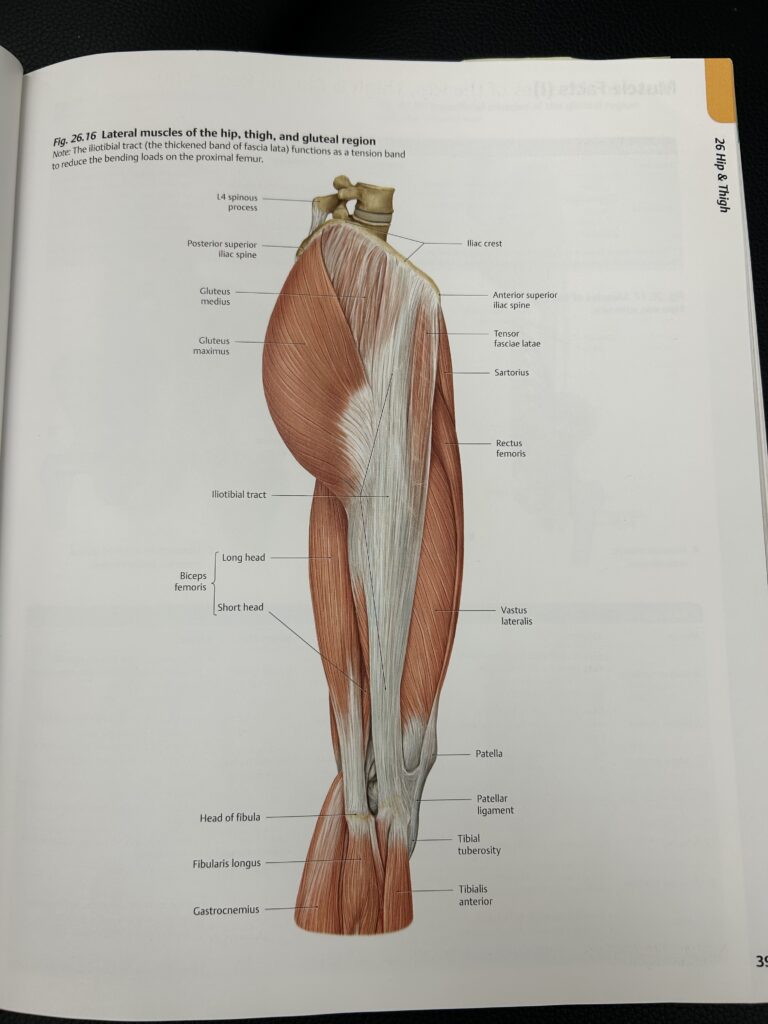
Patellofemoral Pain Syndrome (PFPS) often causes pain over, around, or deep to the knee cap. This can be caused by quadriceps weakness (Fig. 3), glute muscle weakness, fair to poor knee stability & balance on 1 leg, & tension in the quadriceps & hamstring muscles. Most people get pain with this condition while cycling.
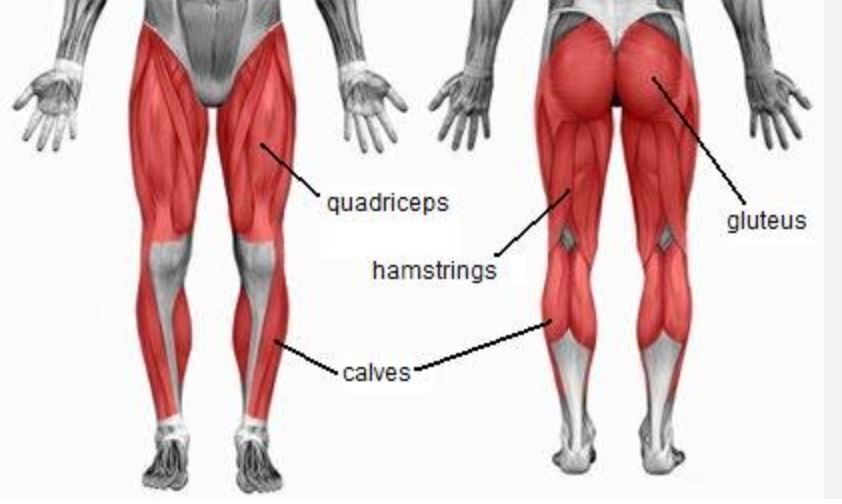
Pes anserine bursitis is caused by weakness and/or tightness of the hamstrings (Fig. 3), adductors (Fig. 4), and/or sartorius (Fig. 5). These muscles all insert on the same common tendon called the pes anserine that that attaches at the front and top of the tibia (shin bone) on the lower leg. Cyclers can suffer achy, dull, sharp, or stabbing pains in the inside of the knee & just below into the upper part of the shin because of the bursa sac (a fluid filled sack) between the pes anserine tendon & the tibia receiving too much pressure & causing it to be inflammed. Most cyclers get pain with this when resting for a while, then trying to be active or after cycling for a while.
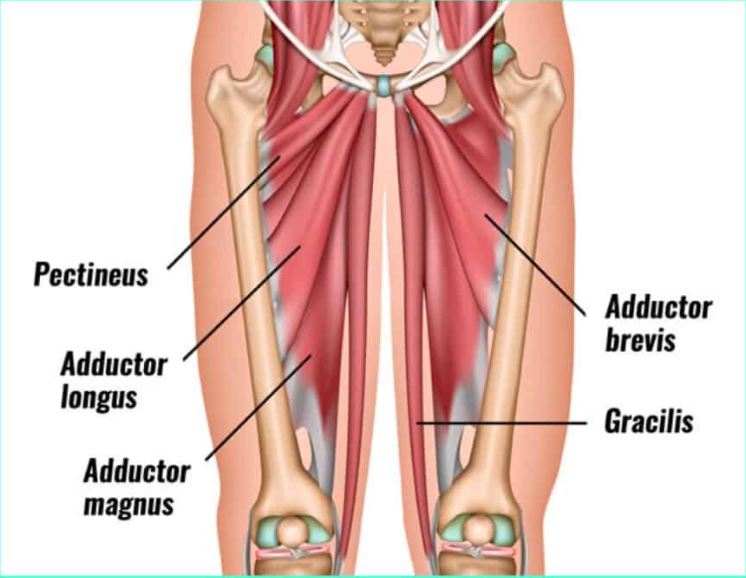
Knee pain caused by these conditions can be managed with the right mix of strengthening, stretching, heat, ice, massage, & adjusting your bike so it fits you properly. In general, your bike should be fit so when you straighten your knee while biking you have a slight bend to the knee still that is comfortable. You also want to make sure your pedals aren’t too far away from the frame or too close as this can cause undo knee pain as well. If you need help with this, discussing it with your local bike shop is helpful. If you are interested in some self treatment to get started with, you can look up our free reports on decreasing pain with biking here. If adjusting your bike & trying these few simple & easy tips & exercises from the free report don’t improve your pain, you may want to schedule to talk with a physical therapist at Inside Track PT on a free 30 minute discovery call or visit to discuss what’s bothering you. You can click the “Inquire Here” button at the bottom of this page to schedule a call/visit online. This can get you back on your bike quickest & with the least hassle so you lose less time training & spend more time enjoying cycling.
Neck Pain
Most cyclers suffer neck pain due to looking up while bent over the handlebars or putting weight through both arms while biking for long periods of time. Most of the time this causes neck muscle tension & pain from sustained neck positioning that isn’t normal or comfortable to the person. If one is suffering a disorder of the neck that is getting exacerbated by biking, such as a disc herniation (Fig. 6), chronic neck muscle spasm or trigger points/knots (examples in Fig. 7), frequent tension headaches, or cervical spine arthritis (Fig. 9), this bent-over-the-handlebars positioning while looking up can exacerbate these problems. Most people with neck pain caused by biking or from a neck injury that is exacerbated by biking have pain in the back & sides of the neck, possible headaches, sometimes pain/numbness/tingling running down the shoulder blades, mid back, and arms, & weakness of both arms that may make it difficult to bike for any amount of time..
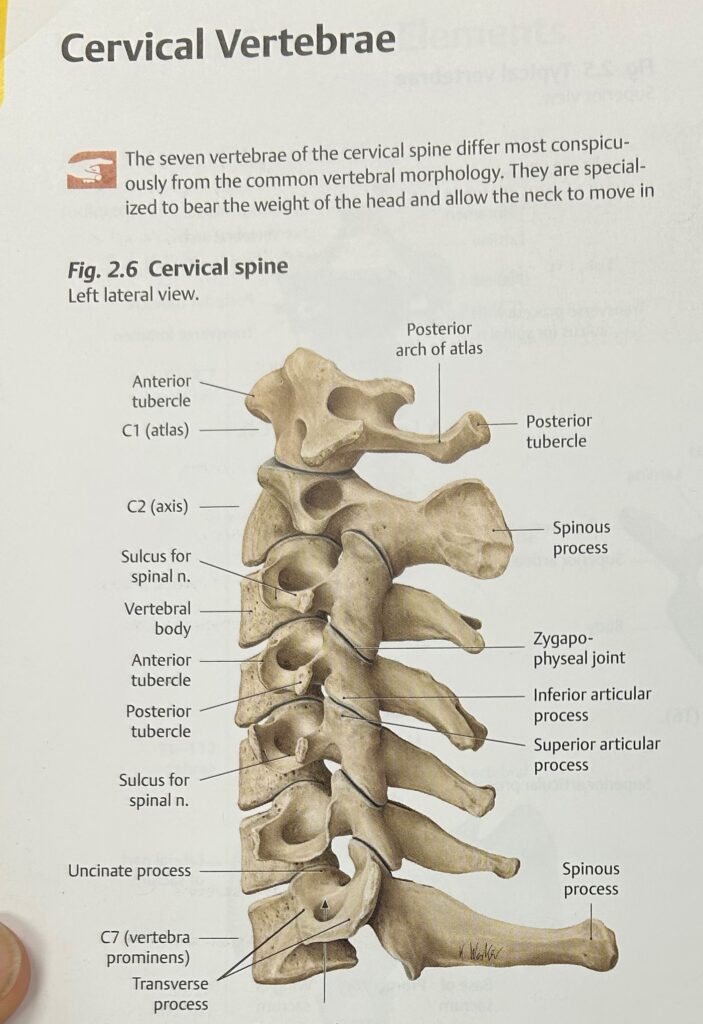
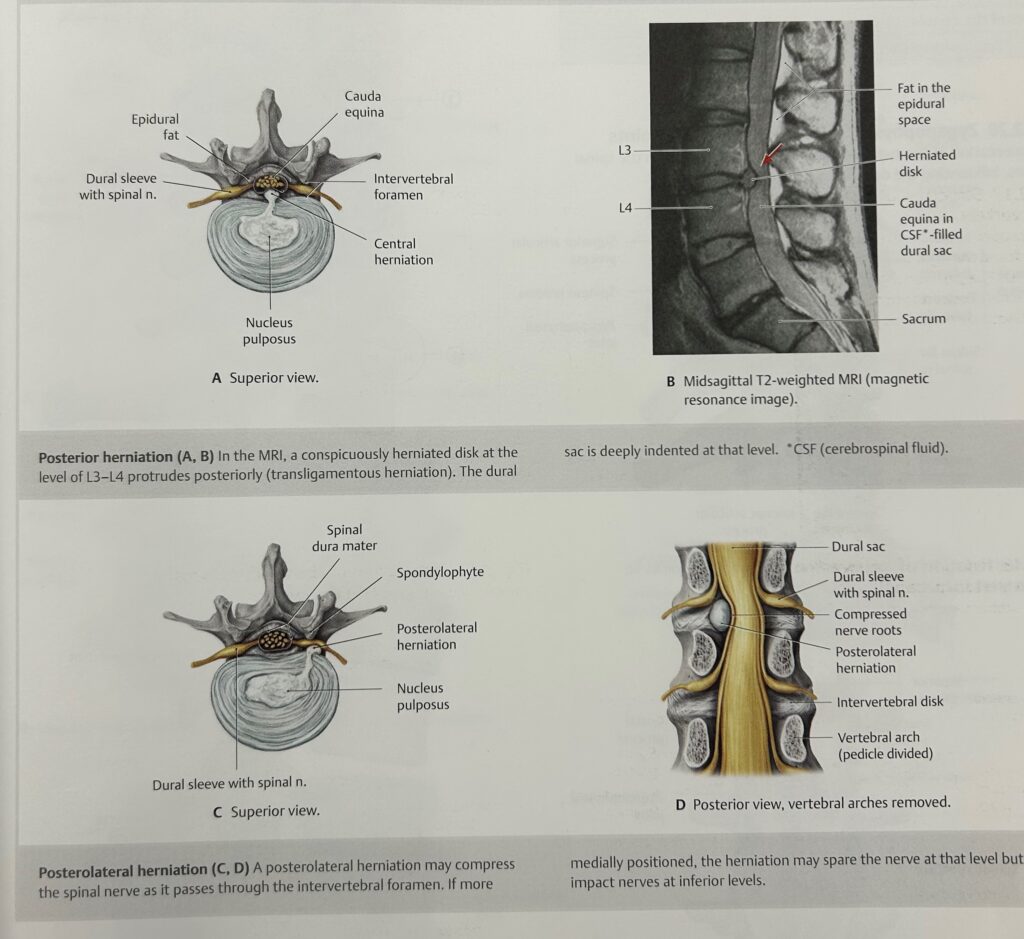
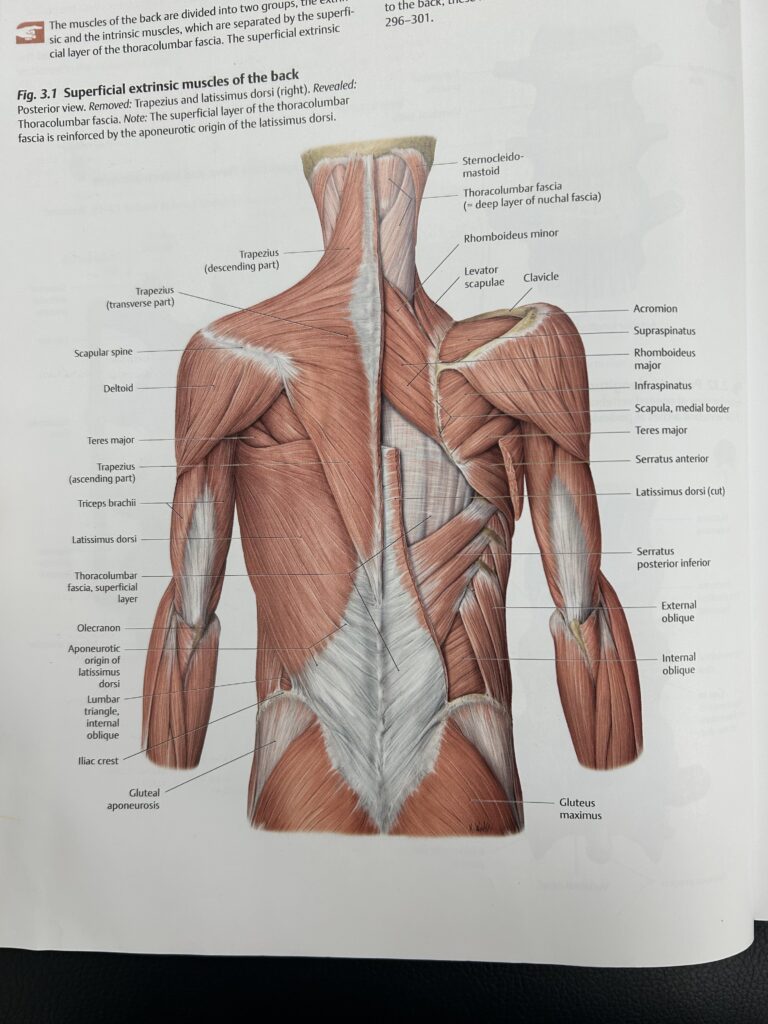
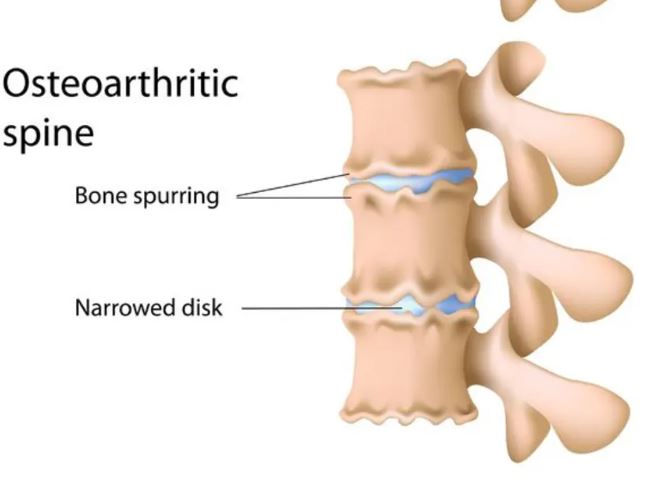
Neck pain can be prevented & mitigated by adjusting your bike so your handlebars are closer to your seat. This prevents you from putting so much pressure through your shoulders & arms which prevents you from hiking your shoulders while biking. You can get new handlebars & have them adjusted at your local bike shop. If this adjustment of your current bike doesn’t work, you may consider getting a bike that is more upright. Another way to decrease neck pain with biking is through strengthening, stretching, massage, ice, heat, & possibly physical therapy. If you are interested in some self treatment to get started with, you can look up our free reports on decreasing pain with biking here. If adjusting your bike & trying these few simple & easy tips & exercises from the free report don’t improve your pain, you may want to schedule to talk with a physical therapist at Inside Track PT. We offer free 30 minute discovery calls or visits. You can click the “Inquire Here” button at the bottom of this page to schedule a call/visit online. During these sessions we’ll discuss what’s bothering you so you can worry more about the route & how hard to push yourself & less about the pain that may prevent you from finishing the ride.
Low Back/Lumbar Spine Pain
Back pain is very prominent in the US. It could be said it falls under the title of epidemic. More often than not it is caused by people pushing through pain, weakness of the core & hips, tension of the hips & hamstrings, and poor posturing. This is no exception in cycling. Most back pain is caused by being stuck in a forward bent position for long periods of time or being upright on a bike for long rides without a back support. Most of the time people suffer low back pain from muscle tension/trigger points or spasms (Fig. 7), lumbar spine arthritis (example in Fig. 9), disc herniation (example in Fig. 6). These conditions can cause pain in the lumbar spine, hips/buttock, & even down the legs to the feet.
Sometimes adjusting your bike can improve low back pain with cycling. If you are leaned too far forward on your bike, you may want to consider a new bike frame where the handlebars are closer to the seat, adjusting your handlebars so they are closer to your seat, or getting new handlebars to put you in a more upright position. You can ask your local bike shop for help with this. If you are interested in some self treatment to get started with, you can look up our free reports on decreasing pain with biking here. If adjusting your bike & trying these few simple & easy tips & exercises from the free report don’t improve your pain, you may want to schedule to talk with a physical therapist at Inside Track PT. We offer free 30 minute discovery calls or visits. You can click the “Inquire Here” button at the bottom of this page to schedule a call/visit online. During these visits we’ll discuss what’s bothering you so you can get back to biking pain free & enjoying the ride!
Sciatica Pain/Buttock Pain
Buttock pain is common in cyclers as it can come on after sitting on your firm bike seat for long periods of time. This comes on most when you start riding again after having taken some time off. Most of the time this pain is caused by increased compression of the piriformis &/or ischial tuberosity (Fig. 11) on long rides. The sciatic nerve runs through this area & compressing these muscles also causes compression of the sciatic nerve. The combination of muscle & nerve compression can cause pain to run through the buttock & down the back of the leg, sometimes to the knee & sometimes all the way to the ankle. The pain running down the back of the leg is well known as sciatica.
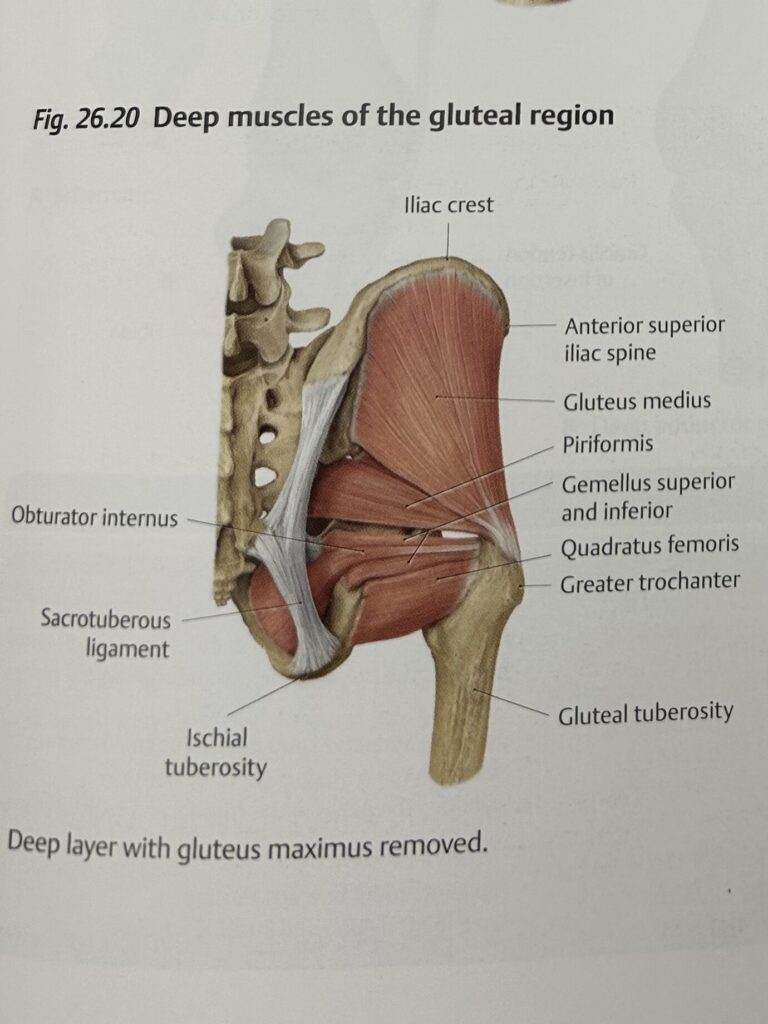
Sometimes cyclers need a softer seat to combat this pain, sometimes they need their bike seat tilted forward so they distribute the weight less on those soft tissue areas & more on their legs & arms as well. You can ask your local bike shop for help with this. If you are interested in some self treatment to get started with, you can look up our free reports on decreasing pain with biking here. If adjusting your bike & trying these few simple & easy tips & exercises from the free report don’t improve your pain, you may want to schedule to talk with a physical therapist at Inside Track PT. We offer free 30 minute discovery calls or visits. You can click the “Inquire Here” button at the bottom of this page to schedule a call/visit online. During these visits you can ask questions about your condition, find the best path for you that avoids taking too much time off, reduces your pain, & keeps you on your bike!
Wrist & Hands
Wrist & hand pain can be caused by compression through the wrists & hands on the handlebars. This can cause excessive wrist pressure at end ranges of motion & can compress nerves & tendons through the wrist, mimicking carpal tunnel & eventually turning to full carpal tunnel unless managed early on.
Ways to manage this are adjusting your bike so your handlebars are either further away or closer to you based on what you need. You can also get different handlebars or caps on the end of your straight handlebars to cushion your hands and wrists to prevent pain. Lastly, cushioned biking gloves are also helpful to decrease pain & numbness/tingling in the wrists with biking. Your local bike shop can help with these adjustments to your bike. If you’re in need of further help to reduce pain after trying to adjust your bike or if your bike is already adjusted properly, you can also try some self-treatment techniques found here in our free reports section. If adjusting your bike & trying these few simple & easy tips & exercises from the free report don’t improve your pain, you may want to schedule to talk with a physical therapist at Inside Track PT. We offer free 30 minute discovery calls or visits. You can click the “Inquire Here” button at the bottom of this page to schedule a call/visit online & we’ll be in touch to help you better understand your condition, what you can do about it, & keep you on your bike!
We at Inside Track Physical Therapy & Wellness hope this gave you the information you need & were looking for to get you back on the trail or road to help you to continue to enjoy your rides in the future.
1. Schuenke M, Schulte E, Schumacher U. Atlas of Anatomy. 2nd ed. (Gilroy AM, MacPherson BR, Ross LM, eds.). New York, NY: Thieme Medical Publishers, Inc; 2012.
2. Sennett, B. (no date) Orthopaedics & physical performance, Cycling Injuries – Sports Medicine Program – UR Medicine, University of Rochester Medical Center – Rochester, NY. Available at: https://www.urmc.rochester.edu/orthopaedics/sports-medicine/cycling-injuries.cfm (Accessed: February 22, 2023).
3. Silberman, M.R. (2013) “Bicycling injuries,” Current Sports Medicine Reports, 12(5), pp. 337–345. Available at: https://doi.org/10.1249/jsr.0b013e3182a4bab7.

